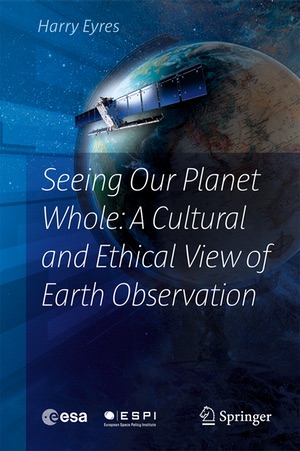Review: Seeing Our Planet Wholeby Jeff Foust
|
| “We could say that we have a duty of care, to ourselves, to our immediate societies, to the wider global community, but also to the Earth itself,” he writes. |
The ability to see the Earth from space, and take in the big—literally global—picture has been one of the major outcomes of the Space Age. It has obvious scientific benefits, including the ability to better forecast the weather, study the changing climate, and monitor the environment. However, it’s also had a cultural impact, even among those people who would otherwise dismiss spaceflight as a frivolity.
Harry Eyres, a former columnist for the Financial Times and, according to his biography, “one of the most eloquent advocates of the worldwide Slow movement,” focuses on those cultural aspects in his book Seeing Our Planet Whole. While a unique approach to the subject, those looking for more insights into the cultural and ethical effects of Earth observation from space may come away disappointed.
Much of the slender book doesn’t have a direct connection with Earth observation at all. Eyres goes though histories of topics ranging from cosmology to the Enlightenment to the environmental movement before addressing Earth observation and its effects on society. That is focused mostly on Western, and predominantly European, society, but with a chapter on worldviews in other societies.
Only much later in the book does he address space-based Earth observation, including a discussion of Europe’s Copernicus program of satellites. He argues that Copernicus is more than just a technical program to monitor the Earth, or an economic one that generates jobs through the production and operation of its satellites. “We could say that we have a duty of care, to ourselves, to our immediate societies, to the wider global community, but also to the Earth itself,” he writes. “This is the premise of an environmental ethics and it would seem that Copernicus is part of the implementation of such an ethics.”
| Seeing Our Planet Whole seems like a missed opportunity to explore how observing the Earth from space has done more than just advance Earth science. |
A later chapter deals with aesthetics. “Earth Observation has rarely been considered from the point of view of aesthetics,” he writes. That is an odd observation, since what makes Earth imagery so compelling to so many people is the striking beauty of the planet when seen from high above. Astronauts taken thousands of pictures of the Earth during their stays on the ISS less for scientific reasons than because those images are considered so fascinating by so many people. Indeed, there is a tiny but persistent niche in the publication industry of books consisting of images of the Earth taken from space, often compiled by the astronauts themselves. This is ignored by Eyres, who instead devotes part of that chapter to the discussion of poems that brought to light the horrors of the First World War.
Just as stepping back to get the big picture of the Earth from space has been enlightening from both scientific and cultural aspects, stepping back from the technology of space-based Earth observation is important as well. However, Seeing Our Planet Whole seems like a missed opportunity to explore how observing the Earth from space has done more than just advance Earth science. Seeing the Earth from space can be, as Kimbrough put it, “pretty humbling,” but translating that experience for the broader public, and, in turn, converting that in action regarding the environment are issues still worthy of examination.
